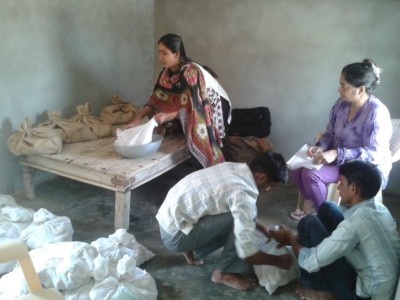CIP Pilot Project of cultivating Potato in Dryland Areas of India with Robust Harvest
When CIP staff first arrived in Jodhpur things felt familiar. The arid landscape, the water table, and the warm days that
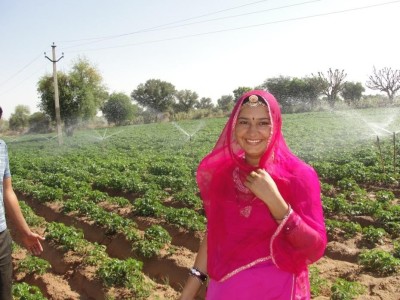
fed into cool evenings were reminiscent of Gujarat- India’s most productive potato growing state, except that at Jodhpur and Jaisalmer district runs along the Pakistan border no potatoes were grown. The land was fertile and free of soil borne diseases, favorable conditions for potato cultivation. Despite the obvious advantages potato farming was non-existent on this stretch of land. Charged by the CGIAR consortium with finding new areas of India to pilot potato program’s as part of an International Potato Center’s (CIP) dryland outreach, Dr. Mohinder Kadian, a Low Land potato scientist, and Sushma Arya, a CIP agronomist, asked themselves, “why not take our experience of Gujarat and apply it in Jodhpur and Jaisalmer?”
The original plan was to start with five farmers and work through a partner because the remote location made it hard to access. “The summer is harsh and the soil sandy and difficult to travel on,” says Sushma. “Once you get down to the field you are completely desiccated because it is so warm and dry.” Local enthusiasm for the project and the potential for real impact, however, made the CIP team decide to not only take the lead on the project but to increase its scope to include 16 farmers in Jodhpur and another 14 in a similar dryland area in Jaisalmer.
Preliminary evaluation trials showed good yields with solid performance by some of CIP clones adapted for heat tolerance and water scarcity. “We began looking at the clones and varieties used in Gujarat and finally decided to start using established varieties,” says Sushma. The yields in the project’s first harvest were far more than anyone had imagined. Whereas the average across India was 23 tons of potatoes per hectare with West Bengal topping in at 29 tons per hectare, one of the first-time potato farmers in Jaisalmer tipped the scales with an encouraging 32 tons of potato per hectare.
Huge Challenge to grow Potato first time in Dryland Areas of Thar desert of Rajasthan

At its inception the project faced an abundance of challenges. In one area, Pokhran, its desert conditions on the edges of India made it a strategic location for nuclear testing in 1974. That testing left environmental problems in its wake that affected crops and impacted the economy of the local area. As a result development came slowly and farmers stagnated in the most rudimentary means of caring for crops. “(We are working with) subsistence farmers growing only rain fed crops. They broadcast seeds and wait for rain to come, it grows and when it is ripe they pick it,” Sushma says. The project needed to cater to farmers starting at zero, many had minimal to no formal education, and were so poor the project had to arrange seeds because the farmers could not afford to purchase them.
Flooding fields is the standard way of irrigating crops. Underground water is limited due to low annual rainfalls. Installing wells is cost-prohibitive for cash-strapped communities. Sprinkler and drip irrigation systems are really the only solution as they reduce waste water by 40%. “With the old traditional method of flooding, water will deplete quickly,” says Mohinder. “Micro-irrigation is a must if these people and agriculture are to survive.” CIP required project farmers to have a sprinkler system in place. With such a small number of participating farmers best practices throughout the potato cycle needed to be enforced to help make them common knowledge for any farmers who signed on to grow potatoes in the future.
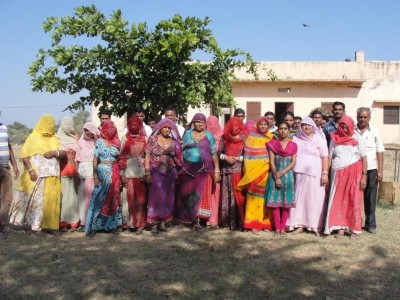
Time and labor saving tools such as planters and diggers were introduced. Labor intensive potato farming can be very costly since labor is a big constraint. These machines drastically reduce labor costs up to 60% and enhance income by up to 20%. CIP is now exploring how it can help empower women by providing them with these tools so that they can create a small business leasing them out for a small profit.
Reluctance to try new option is almost a survival strategy for the world’s poor. Risking losing a modest yet reliable harvest to an untested crop is daunting; the success of others is a big motivator. Farmers are keen to listen to other farmers than outsiders from a research organization therefore, “We brought in two farmers from Gujarat,” Sushma says. “One farmer Manga Ji shared his experience how he started potato farming three decades ago and now he owns a cold store unit. Now one can see the confidence of the farmers in the district build and their decision to grow more area potato.”
Market Linkages – Must to Entice Farmers
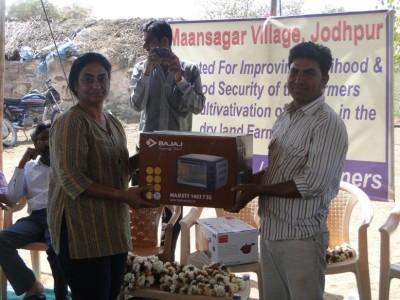
The main question on most farmers’ minds is often, “where will I sell my crops?” Robust harvests are not enough if there is no market. CIP has a healthy relationship with corporate partners and relied on them to help build momentum for the project. PepsiCo was invited to visit both the Jodhpur and Jaisalmer sites to gauge interest in teaming up with CIP potato farmers. Their faith in the CIP brand motivated them to sign on with five of the Jaisalmer farmers on a pilot basis.
PepsiCo provided farmers with seeds and other inputs such as fertilizers on loan and with a guaranteed set price for their harvest. “Farmers are so enthusiastic they are now saying that if PepsiCo comes I’ll dedicate 10 hectares to potatoes,” Mohinder says. “(The PepsiCo partnership) gives people confidence that potatoes will be good business. Some farmers from other districts are coming to see the potatoes. The wave of enthusiasm has started.” Even local government officials are giving their full support and time to the program and are making an effort to associate with their other International Projects like the International Fund for Agricultural Development (IFAD).
CIP hopes to continue to ride that wave by exploring other opportunities for potato farmers in the coming seasons. To help create new prospects for women CIP is looking at potato processing as a business opportunity where women can work from home preparing chips and powder for sale at the local market. Regular meetings with the local government have been conducted to help build momentum to secure support and funding for infrastructure building and investing in things like sprinkler irrigation at a larger scale.
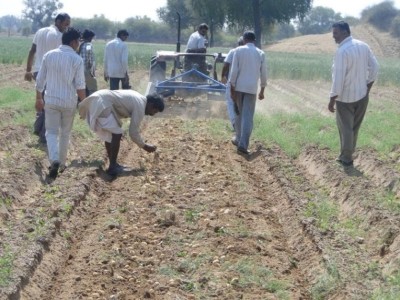
In less than a year the unimaginable has happened, “In this isolated area people are now talking about potatoes,” Sushma says. A farmer from Jodhpur recently told her that when his truck loaded down with potatoes reached the wholesale market shopkeepers preferred his potatoes over the ones brought in from Gujarat or Uttar Pradesh saying that the shining potatoes produced in the sand dunes of Rajasthan were superior.
